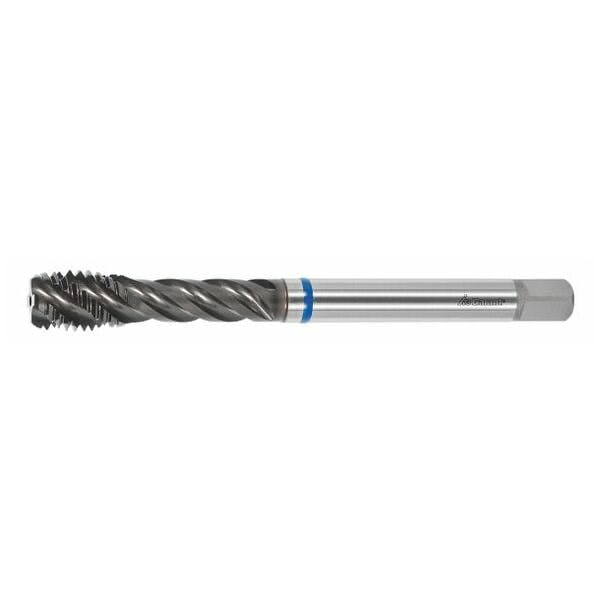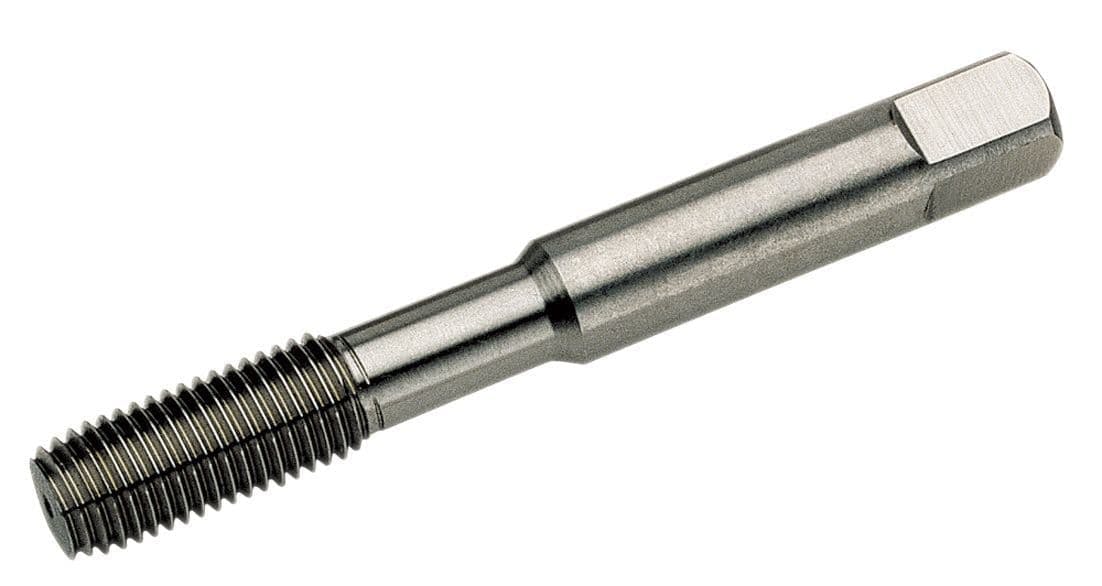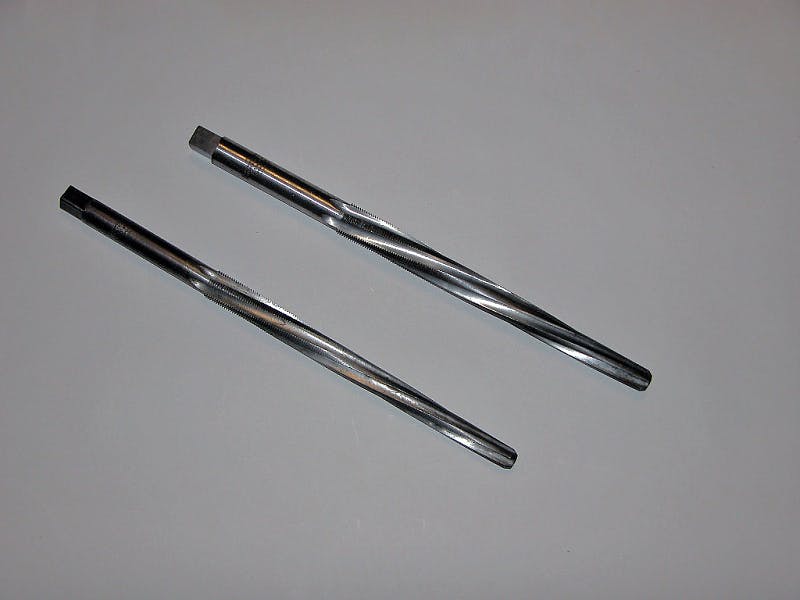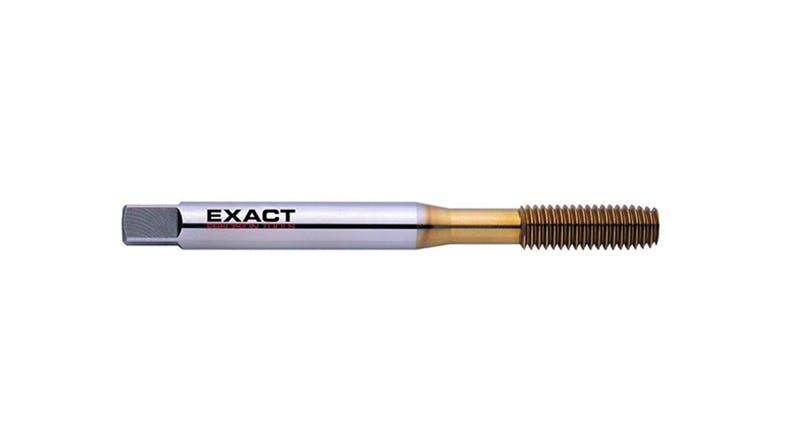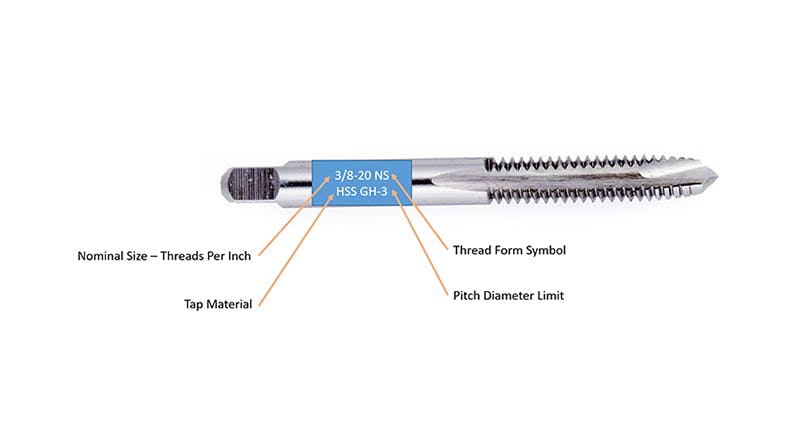
18 Different Types of Thread Taps
There are many different types of thread taps, and knowing exactly when to use each kind can be a bit like a shot in the dark thanks to varying advantages and disadvantages.

Threading taps are used to create holes for threaded fasteners, such as screws and bolts. By manually turning the thread tap, threads are created in the pre-drilled holes of the material. Thread taps come in a wide range of options with varying endpoints, tapers, and flutings, with some more ideally suited to certain applications than others.
Listed below are 15 different types of thread taps:
1. Hand Taps
A hand tap is a tool used to manually carve an internal thread into a piece of material ready for a screw or bolt to be inserted in. A hand-tap set is usually made up of three types of tap: a plug tap, a bottoming tap, and a taper tap. Hand taps are used across a variety of applications as they are multifaceted and adaptable for use by hand as well as tapping under power. Hand taps are also used in general machine tapping and for the majority of materials that have blind- or through-hole conditions. A key feature of the hand taps in comparison to other types of thread taps is the straight flutes to be used in either a shallow blind hole or through hole. Figure 1 shows a set of hand taps:
Hand tap.
Image Credit: https://threadingtoolsguide.com/en/blog/hand-tap/
Plug Tap
A plug tap is a type of hand tap, distinguished from bottoming and taper taps by the length of its cutting chamfer. A plug tap has a five-thread chamfer and slowly removes material in the thread beginning with the smaller diameter of the thread. Plug taps are most commonly used for through holes and where there is enough room at the bottom of a blind hole. One of the main advantages of plug taps is that they are easy to use through holes, but provide a more complete set of threads in comparison to taper taps. However, a plug tap is not as well suited to blind holes as taper taps. Figure 2 shows a plug tap:
Plug tap.
Image Credit: https://www.redlinetools.com/resources/tap-information
Bottoming Tap
A bottoming tap is a type of hand tap used to cut threads. It is important to note that the bottoming tap has the smallest thread chamfer of 1.5 and is used to complete the end portion of a blind hole. One of the main advantages is that it can get right to the bottom of a blind hole to complete the threading, unlike a plug or taper tap. However, it is not well suited to removing the majority of material from the hole. Figure 3 shows a bottoming tap:
Bottoming tap.
Image Credit: https://www.redlinetools.com/resources/tap-information
Taper Tap
A taper tap is a form of hand tap used to cut threads into a piece of material. Taper taps have a nine-thread chamfer and have the smallest diameter of all hand taps. Taper taps are usually used as starter taps in blind holes or through-hole applications. One of the advantages of taper taps is that they can remove the majority of material initially, however, they are not particularly suited to completing the bottom of blind holes as they tend to leave incomplete threads. Figure 4 shows a taper tap:
Taper tap.
Image Credit: https://www.redlinetools.com/resources/tap-information
2. Pipe Tap
Pipe taps are a tool used to carve internal thread into parts that will be fitted to form a pressure-tight joint. Pipe taps come in different varieties, with some designed for hydraulic and gas applications, mechanical joints, and hose couplings. Pipe taps are used specifically for threading pipes and must be used more accurately in comparison to other forms of tapping as they are designed and made to mechanically seal a joint for pressure and prevention of leaks. Figure 5 shows a pipe tap:
Pipe tap.
Image Credit: https://www.hardwareandtools.com/century-drill-95201-1-8-27-national-pipe-thread-tap-ukdb-6620.html
3. Spiral Flute Tap
Spiral flute tap is a form of thread tap used widely across the manufacturing industry. A spiral flute tap has flutes wrapped around the tap’s axis in a helical or spiral formation. Spiral flute taps are commonly used for tapping threads into blind holes and then pulling the chippings out of the hole in the opposite way to the tapping direction. In comparison to hand taps, spiral flute taps do not offer as strong of a cutting edge and have spiral-shaped flutes. Figure 6 shows a spiral flute tap:
Spiral flute tap.
Image Credit: https://www.presto-tools.co.uk/ProductGrp/bsw-spiral-flute-taps-iso-529
4. Gas Tap
A gas tap is a type of threading tap. It is commonly used to cut deep threads for merging pipes and hydraulic fittings. Gas taps are ideally suited for both conical and cylindrical shaped holes due to their one- or two-thread chamfers, unlike the much wider nine-thread chamfer taper tap. Figure 7 shows a gas tap:
Gas tap.
Image Credit: https://www.ebay.co.uk/itm/152123363582
5. Machine Tap
Machine taps are used for threading and have grown in popularity and importance recently in line with the increased use of machinery in production. Threading tools used in these machines are now required to be increasingly wear-resistant and durable. Machine taps are fully automated and used in threading hard materials and are suited to both blind holes and through holes. Machine taps are used for hard materials, unlike spiral flute taps. Figure 8 shows a machine tap:
Machine tap.
Image Credit: https://www.cutwel.co.uk/m6-x-1mm-metric-coarse-uncoated-carbide-machine-tap-cutwel-pro
6. Thread-Forming Tap
Thread-forming taps are also known as form taps, roll taps, or fluteless taps, and they create threads by removing the material without producing chips. Thread-forming taps are commonly used on medium alloys and mild steels such as: copper, aluminum, brass, and stainless steel. Unlike other forms of thread taps such as hand taps, the thread-forming tap molds the material to form threads, as opposed to cutting it. Therefore, the material is displaced inside a hole to make space for threads to be formed. Figure 9 shows a thread-forming tap:
Thread forming tap.
Image Credit: https://www.raptorsupplies.co.uk/pd/osg/1400106205
7. Master Tap
A master tap is a variety of threading tap and is widely used across a range of industries. Master taps are known for their universality and diversity and are most commonly used to cut clean threads in strong and hard materials. Master taps are similar to taper taps, however the key difference is in the number of flutes. The master tap has more cutting faces and on average 7 to 10 flutes. Figure 10 shows a master tap:
Master tap.
Image Credit: https://www.hoffmann-group.com/US/en/hus/Machining/Thread-machining/Taps/Dynamic-taps/GARANT-Master-Tap-INOX-machine-tap-HSS-E-PM-Form-C-6HX-TiAlN/p/135732
8. Combined Drill and Tap
A combined drill and tap enables the manufacturer to drill the hole and tap threads in one operation, without the need to switch tools, saving both time and money on a production drilling job. It can be used for a variety of materials, including: aluminum, malleable iron, and brass. Similar to a spiral flute, this implement has a helical flute design. Figure 11 shows a combined drill and tap:
Combined drill and tap.
Image Credit: https://www.newmantools.com/nat/drill_tap.htm
9. Solid Carbide Tap
Solid carbide taps are threading implements made of composite material that consists of sintered ultra-fine tungsten carbides. They are commonly used on hard materials as solid carbide has an extremely high hardness and wear resistance. One of the key benefits of solid carbide taps is the long life span of this tool, even in more challenging working environments. Figure 12 shows a solid carbide tap:
Solid carbide tap.
Image Credit: https://karnasch.tools/uk/all-products/tools-for-threading/tap-drill-bits/m3-solid-carbide-machine-taps-22202503/
10. Extension Tap
Extension taps provide an alternative form of thread tap. Due to their long shank on top of the body, extension taps are commonly used to reach more inaccessible holes, for example, the hub of a pulley. The extension tap is very similar to hand taps. Figure 13 shows an extension tap:
Extension tap.
Image Credit: https://www.cromwell.co.uk/shop/cutting-tools/taps/taper-tap-m3-x-0-5mm-straight-flute-extension-metric-coarse-high-speed-steel-bright/p/SHR0850230G
11. Fluteless Tap
A fluteless tap is a form of threading tap that utilizes a pressure deformation technique to cut threads into a material. Fluteless taps are used only on softer metals and, unlike other forms of threading taps, the threads through the body are without flutes. Similar to a thread-forming tap, there is no chip removal with this form of threading and this allows for high-quality threads with fast cutting speed. Figure 14 shows a fluteless tap:
Fluteless tap.
Image Credit: https://www.gwr-fasteners.co.uk/v-coil---m6-x-1mm---fluteless-sti-machine-tap-89061-p.asp
12. Machine Screw Tap
Machine screw taps are used to carve threads into the material and have on average 2–4 threads tapering from the tip. By their design, machine screw taps are used to manually thread deep holes in a variety of material types. Manufacturers utilize the machine screw tap for routine maintenance, repairs, and rethreading in situations in which tight tolerance and accuracy are not necessary. Unlike machine taps, machine screw taps are not fully automated—they are used alongside a tap drill machine or a manual tap handle. Figure 15 shows a machine screw tap:
Machine screw tap.
Image Credit: https://www.made-in-china.com/products-search/hot-china-products/Screw_Tap.html
13. Spiral Point Tap
A spiral point tap is an alternative form of threading tap used to create threads into a material. By its design, the spiral point tap is used in situations in which higher tapping speeds are required, with lower power to drive and greater strength than other threading taps. In comparison to conventional taps, a spiral point tap has a shallower flute passage, enabling the spiral point tap greater cross-sectional area. While they may be considered very similar compared to a straight flute tap as they share the same general physical dimensions, the key differentiator is the cutting face of the spiral point tap. Figure 16 shows a spiral point tap:
Spiral point tap.
Image Credit: https://www.rennietool.co.uk/products/hss-ba-spiral-point-taps
14. Stay Bolt Tap
A stay bolt tap is a type of thread tap, roughly 15–20 inches long that is designed to cut threads in drilled holes for the threaded machine screws or threaded bolts to be screwed in. Stay bolt taps were commonly used in the application of locomotive boilers, predominantly in the repair and installation of fireboxes in steam locomotives. The distinct feature of this thread tap is that it threads holes that match the diameter of a stay bolt nut. Figure 17 shows a stay bolt tap:
Stay bolt tap.
Image Credit: https://www.si.edu/object/nmah_1212991
15. Bent Shank Tap
A bent shank tap is one option for thread tapping, whereby threads are cut into a material. This form of tap is used with automatic tapping machines that release nuts through the shank. In comparison to other thread taps, a bent shank tap has the distinct feature of a bent handle extending from the tang. This enables the tap to continuously tap, without the need to stop the drilling machine at different intervals. Figure 18 shows a bent shank tap:
Bent shank tap.
Image Credit: https://tooling.tw/tools_nut-tap-bnt.html
16. Interrupted Thread Tap
These thread taps only have a tooth for every other thread. The idea is to provide improved chip extraction. Removing every other tooth helps break chips and also provides more room for the chip to escape and for lubricant to come in and do its job.
17. Pipe Taps
As you might expect, Pipe Taps are the types of thread taps used for tapping pipe threads. There are both straight and tapered pipe taps depending on whether the pipe thread is intended to be straight or tapered. The photo shows a typical NPT Thread Pipe Tap. You can see the taper of the NPT thread profile.
Taps for tapered pipe threads have to work harder because you can’t drill a tapered hole. There’s quite a lot more material they must remove at top of hole than bottom. Use a pipe taper reamer to taper the hole so the tap doesn’t work so hard.
18. Form or Roll Taps (Thread Forming Taps)
Thread Forming taps don’t cut threads at all. Instead they cold form. Threads made this way are often called “rolled” threads.
With this process, the metal is pushed out of the way and compressed into position rather than being cut. There are no chips to remove. As a result, the taps themselves are less likely to break and the threads they make are stronger. If your application allows Form Taps, they are generally the best thing going for those reasons.
Form Taps do require different feeds and speeds and they require a different starting hole size, so be aware of that before using one.
While many believe they’re only good for soft materials like aluminum, they can actually be used on materials up to a hardness of 36 HRC, which is about 340 BHN. That covers a surprisingly wide range of materials including a lot of steels.
I will almost always choose a Form Tap over a Cutting Tap out of the available types of taps if the material isn’t too hard for thread forming.
Tip:
“One minor hiccup with quite a few of the roll forming taps…unless they have a groove to allow cutting oil to escape, or there is no room at the root or crest of the thread, the oil will build up back pressure as the tap goes in, and eventually act like solid metal plug blocking further entry of the tap into the hole. I figured this out the hard way after breaking a few taps.”
The markings typically will include:
- Nominal Size: This is the description of the thread size that tap will make.
- Thread Form Symbol: This describes the thread family.
- Tap Material: Usually Carbide or HSS
- Pitch Diameter Limit: Tells what tolerance thread will be made.
Pitch Diameter Limits (Threads < 1″ in diameter)
L1 = Basic to Basic minus .0005
H1 = Basic to Basic plus .0005
H2 = Basic plus .0005 to Basic plus .0010
H3 = Basic plus .0010 to Basic plus .0015
H4 = Basic plus .0015 to Basic plus .0020
H5 = Basic plus .0020 to Basic plus .0025
H6 = Basic plus .0025 to Basic plus .0030
Note: You can find these limits in G-Wizard’s thread database too.
Thread Form Symbols / Abbreviations
ACME 60° STUB 60° Stub thread form
ACME STUB Stub Acme thread form
ACME-C Acme thread – centralizing
ACME-G Acme thread, general purpose
ANPT Aeronautica National Form taper pipe thread
AWWA American Water Works Association
BA British Association Standard thread form
BSF British Standard Fine thread series
BSPP British Standard Pipe Parallel
BSPT British Standard Pipe Taper
BSW British Standard Whitworth
MM ISO Metric thread form
N BUTT American Buttress screw thread
NC American National Coarse thread series
NEF American National Extra-Fine thread series
NF American National Fine thread series
NGO American National gas outlet threads
NGT American National gas taper threads
NH American National hose & fire hose coupling
NM National Miniature thread series
NPS American Standard straight pipe thread
NPSC American Standard straight pipe thread in couplings
NPSF American Standard internal straight pipe thread (dryseal)
NPSH American Standard straight pipe thread for hose couplings & nipples
NPSI American Standard intermediate straight pipe thread (dryseal)
NPSL American Standard straight pipe thread for locknuts
NPSM American Standard straight pipe thread for mechanical joints
NPT American Standard taper pipe thread
NPTF Dryseal American Standard taper pipe thread
NPTR American Standard taper pipe thread for rail fittings
NS Special threads of American National Form
PTF Dryseal SAE Short Taper pipe thread
SGT Special Gas Taper thread form
SPL-PTF Dryseal Short Taper Pipe thread
STI Special Threads for Helical Coil Wire Screw Thread Inserts
UN Unfied and American thread series
UNC Unfied and American Coarse thread series
UNEF Unfied and American Extra-Fine thread series
UNF Unfied and American Fine thread series
UNIV Unified Miniature Thread Series
UNJ Unified Thread Series with Controlled Root Radius
UNJC Unified Coarse Thread Series with Controlled Root Radius
UNJF Unified Fine Thread Series with Controlled Root Radius
UNR Unified Constant Pitch thread series with Controlled Root Radius
UNRC Unified Coarse Thread Series with Controlled Root Radius
UNRF Unified Fine Thread Series with Controlled Root Radius
UNS Unfied and American threads of selected special diameters and pitches
Why Does Machining Require Different Types of Thread Taps?
Machining requires different types of thread taps because different taps can cut different types of threads in the holes and have different associated features. Machinists must take into account the type of workpiece, tap material, type of hole, and cutting speed when selecting the type of thread tap. Manufacturers tend to employ taps from high-speed steel for softer metals (for example aluminum) as they can enable a slower and more controlled cutting action.
To learn more, see our full guide on Tapping in Machining.
How To Choose a Thread Tap To Use?
When choosing a thread tap to use, it is important to consider four main factors to maximize the chances of a successful threading process. Firstly, the type of workpiece. Different materials have differing levels of firmness, therefore the tap type varies as some have distinct features that make them more suitable for certain materials. For example, a machine tap is likely to work better on harder materials, whereas a fluteless tap is better suited for softer metals. Secondly, the tap material must be taken into account. For instance, carbide steel taps can cut threads very quickly and are strong for hard materials such as cast iron. Thirdly, the type of hole is important in choosing a thread tap as the taps have a range of thread chamfers. For example, taps with 1–3 thread chamfers are capable of making deeper holes. Fourthly, the cutting speed is important to factor in when choosing a thread tap as some taps are specially designed for high-speed production. Should speed be a crucial factor, the best type of thread taps are spiral fluted taps.
How Can Xometry Help You Choose a Thread Tap?
Xometry can help you choose the right thread tap for your application by putting you in contact with engineering experts from start-up companies and Fortune 100 companies alike. You can use the Xometry quoting tool to search for a company that can help you find the engineering solution you need. These experts will be able to help you use the right thread-tapping tools in your project. Alternatively, Xometry has a team of customer-support agents and engineering experts who can help you choose the right thread tap for your application.
What Is the Standard Type of Thread Tap?
The standard type of thread tap is widely considered to be a hand tap as they are multifaceted and adaptable for use by hand and are also generally popular in machine tapping. They work efficiently with the vast majority of materials that have blind holes or through holes. Another commonly used type of thread tap is the taper tap. This type of tap has a lot of taper to help it ease gradually into cutting threads. It is commonly used as a starter tap for particularly difficult or blind holes.
What Is the Type of Thread Tap Used for Bronze?
A machine tap is an example of a type of thread tap used on bronze. Bronze is widely considered to be a hard metal, so it is important to select a thread tap that is capable of creating threads in harder substances, such as machine taps as they are fully automated. Other alternatives used for bronze include master taps or solid carbide taps as they are both ideally suited to hard material.
What Is the Type of Thread Tap Used for Metal?
One of the types of thread taps used on metal is the straight flute tap. This is due to the larger cross-section on the straight flute tap’s cutting edge that makes it ideally suited to cut threads into hardened metals. The straight flute tap is an extremely robust cutting tool, and unlike the spiral flute tap, the flutes run directly down the tap’s shaft.
What Is the Type of Thread Tap Used for Concrete?
When screwing into concrete a thread tap isn’t used, instead, self-tapping screws are used. These are screws with a coarse thread. The coarse thread is used because it is impossible to create a fine thread in concrete, unlike in metal. To use a self-tapping screw an undersized hole is drilled into the concrete and then the self-tapping screw is drilled into the concrete.
What Is the Type of Thread Tap Used for CAM Milling?
Machine taps can be used for CAM (computer-aided manufacturing) milling. Machine taps are fully automated and are therefore compatible with specialized software that automates the manufacturing process. Machine taps can be used on a wide variety of materials used in CAM milling and can be used to thread both through and blind holes.
Summary
This article presented the different types of thread taps, explained each of them, and discussed how and when to choose which type of thread tap. To learn more about thread taps, contact a Xometry representative.
Xometry provides a wide range of manufacturing capabilities, including machining and other value-added services for all of your prototyping and production needs. Visit our website to learn more or to request a free, no-obligation quote.
Disclaimer
The content appearing on this webpage is for informational purposes only. Xometry makes no representation or warranty of any kind, be it expressed or implied, as to the accuracy, completeness, or validity of the information. Any performance parameters, geometric tolerances, specific design features, quality and types of materials, or processes should not be inferred to represent what will be delivered by third-party suppliers or manufacturers through Xometry’s network. Buyers seeking quotes for parts are responsible for defining the specific requirements for those parts. Please refer to our terms and conditions for more information.










